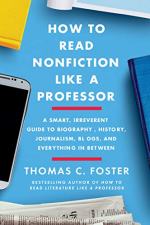
|
| Name: _________________________ | Period: ___________________ |
This quiz consists of 5 multiple choice and 5 short answer questions through Section 3: Chapter 9, "Living the News" through Chapter 12, "That Is So Last Year".
Multiple Choice Questions
1. In Chapter 8, "Bringing the News," Foster describes the Larry Nassar scandal as an illustration of what?
(a) The importance of community newspapers.
(b) The difficulties of investigative journalism.
(c) The ways in which trusted people can betray others.
(d) How major universities sometimes engage in cover ups.
2. According to "The Building Blocks of Arguments," what is the implicit argument of most nonfiction writing?
(a) That the subject matter is important enough to read about.
(b) That the writer's angle on the subject is the correct one.
(c) That the writer has the authority to write about the subject.
(d) That the reader should change their beliefs or behavior.
3. In Chapter 2, "The Ecology of the Nonfiction Biosphere," how does Foster define "specialty journalism"?
(a) Forms of journalism devoted to a single subject area.
(b) Editorial writing.
(c) Feature writing.
(d) The newspaper sports section.
4. In Chapter 10, "From the Inside Out," which claim does Foster make about thesis statements?
(a) A thesis can be placed anywhere in an essay.
(b) An implied thesis is more sophisticated than a directly stated thesis.
(c) It does not need to limit the content of the essay.
(d) No one can truly come up with a "unique" thesis.
5. In Chapter 1, "The Structure of Nonfiction Information," what are the "four Ps" that Foster discusses?
(a) Purpose, proposal, program, and plan.
(b) Purpose, paraphrase, platform, and paragraph.
(c) Problem, promise, program, and platform.
(d) Problem, proposal, program, and plan.
Short Answer Questions
1. According to "The Building Blocks of Arguments," what purpose do warrants serve?
2. In Chapter 5, "It May Just Be Me, But..." Foster says that a source's quote can be "emended" (55). What happens to an emended quote?
3. In Chapter 9, "Living the News," which authors does Foster point out as not engaged in New Journalism?
4. In Chapter 6, "Source Code," what does Foster call the "gold standard" of sources (63)?
5. In Chapter 11, "Life from the Inside," Foster discusses the use of parallelism. He is discussing what technique?
|
This section contains 377 words (approx. 2 pages at 300 words per page) |

|




